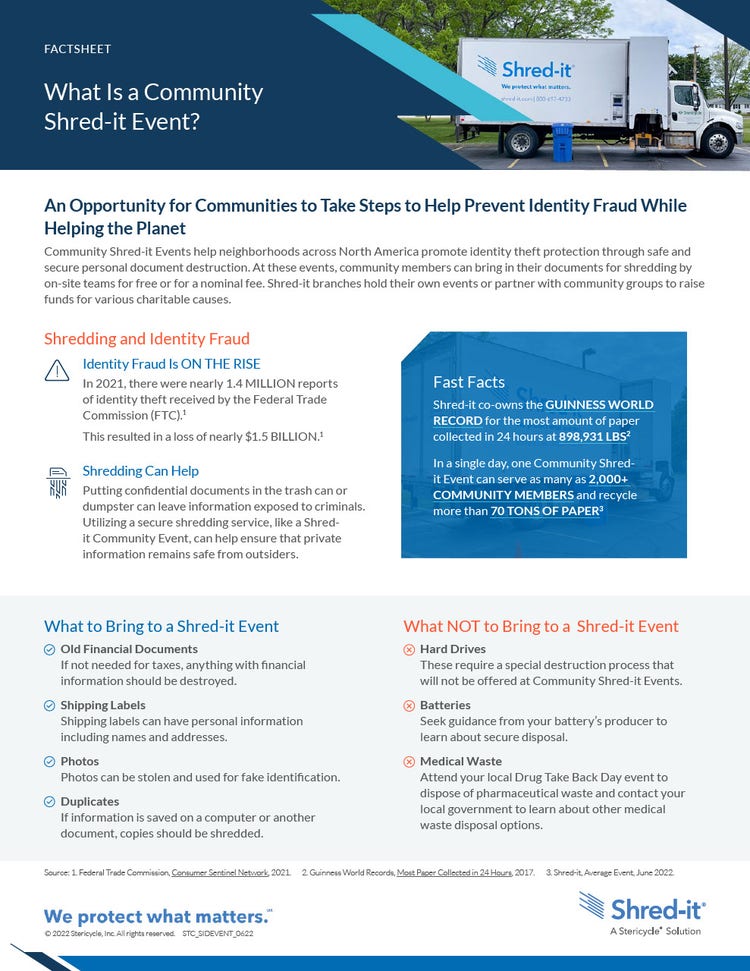June 17, 2022
What Do I Do with My Confidential Information?
Learn How a Community Shred-it Event Can Help You Protect Your Confidential Information
Every year, Shred-it locations host Community Shred-it Events to promote information security and recycling in local neighbourhoods. These events may be done in partnership with local businesses or community groups to raise funds for various charitable causes, and they give community members the opportunity to have their personal documents destroyed by on-site shredding trucks for free or for a nominal fee.
Some consumers may not be aware of Community Shred-it Events in their area or how and why they should participate. The following provides information on what to expect at a Community Shred-it Event and benefits to participants.
How Can Community Shred-it Events Help Prevent Identity Fraud?
Identity theft continues to be a growing problem for consumers across Canada. The number of identity thefts has increased during the pandemic. During the three years before COVID-19, reports of ID fraud were stable at around 9,500, but in 2020 that average increased to 17,377. According to the Canadian Anti-Fraud Centre, Canadians lost $106.4 million to fraud in 2020.
Disposing documents in the trash or recycling bin with personally identifiable information (PII), such as names, addresses, financial information, bank account numbers, social insurance information, and more, can increase the chances of physical data theft. “Dumpster divers” can steal these documents from the trash and use them to commit crimes such as withdrawing money, getting a credit card or loan, opening a utility account, stealing tax refunds, and receiving medical care.
Community Shred-it Events help ensure that sensitive personal information is securely destroyed, reducing the chances of identity theft.
What Are the Other Benefits of Community Shred-it Events?
In addition to helping prevent identity theft, Community Shred-it Events promote sustainability, as all shredded documents are ultimately recycled. A single Community Shred-it Event can result in the recycling of more than 70 tons of paper.
Shred-it locations often partner with local non-profit organizations to raise money during Community Shred-it Events. By participating in these events, consumers can connect with their fellow community members and contribute to a great local cause.
In addition, these events promote and highlight the importance of information security and reinforce a sense of community that builds goodwill.
What Should Consumers Bring to Community Shred-it Events?
Residents can and should bring any paper documents containing personal information to Community Shred-it Events. Some examples include:
- Duplicates: Most consumers do not need to save both a paper and electronic copy of a document. If an electronic record is saved, paper duplicates can be shredded.
- Unneeded financial documents: The CRA advises that individuals keep tax-related documents for six years in most cases. Tax documents older than six years, as well as unneeded bank statements, ATM receipts, and other financial information can be shredded at Community Shred-it Events.
- Unnecessary receipts and bills: Credit card and utility bills should be destroyed once paid. Consumers should also shred sales and medical receipts unless they are related to warranties, taxes, or insurance.
- Expired policies: Home and car insurance policies contain a lot of confidential information. Once the insured period is over and the policy is no longer in effect, these documents should be slated for secure destruction unless needed for tax purposes.
- Junk mail: Names and addresses are often included in pre-approved credit card applications and other promotional mail. If junk mail contains any personal information, it should be shredded.
- Shipping labels: Any online or other purchases delivered to a home or office contain labels that often include confidential information such as address, tracking codes, and account numbers. These labels should be removed from boxes prior to recycling and saved for a Community Shred-it Event.
- Photos: Photos of friends and family could be stolen and used for fake identification, so consumers should opt to dispose of them through secure shredding.
What Shouldn’t Consumers Bring to Community Shred-it Events?
Community Shred-it Events only offer paper document shredding services, so consumers should not bring any specialty information storage or other types of waste, including:
- Computers and hard drives: These items require a special destruction process that will not be offered at Community Shred-it Events.
- X-rays: While X-rays might look like documents, they require a specialized shredding process that differs from a paper shredder.
- Batteries: To securely destroy batteries, consumers should seek guidance from the battery producer.
- Pharmaceutical waste: The safest way to dispose of unneeded pharmaceutical waste, including prescription pain medications, is to return them to any pharmacy in Canada at any time of the year. Some cities and police departments also offer take back programs.
- Glass and metal waste: Although this waste should be disposed carefully, it does not require any special destruction process.
- Food and other types of waste: Any non-paper items that do not have personal information can be discarded in the trash or recycling bin.
If Consumers Have Specialty Products That Can’t Be Destroyed at a Community Shred-it Event, What Should They Do?
While Community Shred-it Events only manage paper document destruction, the Shred-it team can destroy many other types of information storage, from hard drives to building entry passes to binders. Visit our specialty information destruction page to learn more.
To find a Community Shred-it Event near you, download our infographic and visit our Community Shred-it Events page.
